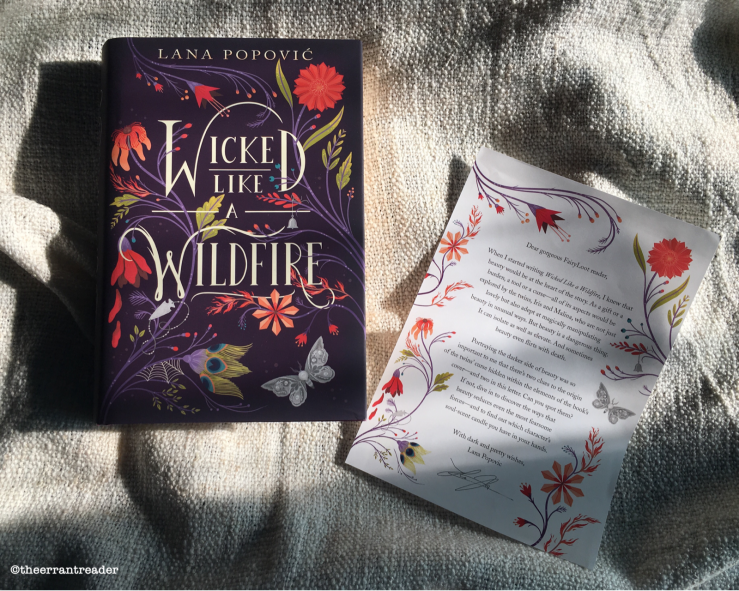Wicked like a Wildfire
by Lana Popović

Synopsis
All the women in Iris and Malina’s family have the unique magical ability or “gleam” to manipulate beauty. Iris sees flowers as fractals and turns her kaleidoscope visions into glasswork, while Malina interprets moods as music. But their mother has strict rules to keep their gifts a secret, even in their secluded sea-side town. Iris and Malina are not allowed to share their magic with anyone, and above all, they are forbidden from falling in love.
But when their mother is mysteriously attacked, the sisters will have to unearth the truth behind the quiet lives their mother has built for them. They will discover a wicked curse that haunts their family line—but will they find that the very magic that bonds them together is destined to tear them apart forever?
My personal review of the book
2.5 stars
Wicked like a Wildfire is the first book of the Hibiscus Daughter series, and the debut novel of Lana Popović. It is a contemporary/fantasy YA book, since it contains elements typical of the fantasy genre, while the setting is contemporary Montenegro—the city of Cattaro, to be specific.
I have no sense of smell, so when I received this book in my august Fairyloot package I decided to try and read it with an open mind. I thought “Maybe it will even help me somehow…to remember what it felt like to actually smell perfumes and aromas and such,” thus I started it hopeful, open minded and expectant.
Well, it was disappointing: I didn’t expect it to be perfect or mind-blowing, but I didn’t think it would be this boring either.
Let me explain myself: the twin sisters Iris and Malina and their story are interesting, because of their magical roots, and all the possibilities this magic had to expand into something riveting.
They grew up with an overbearing witch of a mother (Jasmina) that imposed strict rules to them: they had to keep their magic gifts—it is called the “gleam“: Iris sees flowers as fractals and turns her kaleidoscope visions into glasswork, while Malina interprets moods as music—a secret, even from their best friends, and they could NEVER, NEVER fall in love.
“The only real bedtime story Mama ever told us traced back to those early days, when we were both so little the tops of our skulls hadn’t yet hardened into something that could withstand the world.”
Everything goes on “smoothly”—if you don’t count the fights between Iris and her mother Jasmina—until…until Jasmina is attacked, she finds herself in a dead/undead state, and her daughters have to uncover the secrets of their family’s history and find a way to save her…if they can.
It sounds promising, right? And it would be…if it wasn’t covered by layers of boring dialogues (mostly about an infinity of flowers and scents and flavours) and uncalled for digressions. If you use lush descriptions about their powers—the ability to “bloom” fractals, and sing and such—once or twice it is ok, maybe even necessary, because the reader has to understand how things work in that world. But if you overload her or him with a tons of those descriptions (they last for entire paragraphs sometimes), you risk to bore said reader to death. So that when she arrives at the moment in which the story starts to pick up speed and things finally are happening, she might be not so interested anymore.
Apple, mango, strawberry, papaya, prickly pear,some so exotic she could only have gotten them from the cruise ships that docked in the bay, rather than the open-air market outside the Old Town walls. Each was at its peak, the perfect moment of ripeness before turning. Then she passed violet petals beneath our noses, followed by jasmine, orchid, and peony; small lumps of ambergris; splinters of oud wood and sandalwood and myrrh. Waiting to see which would bring forth the gleam, the magic that ran through our blood.
I was that kind of reader, no matter my personal interest in the descriptions, they were too many even for me, and they slowed the pace of the story way too much. Morevore: I don’t care so much about all the possible kind of flowers that exist in the world, or their colors, especially if I find constant repetitions about how beautiful they are and how colorful and… At some point, she should have hit pause on the descriptions and on with the storyline.
FYI, the Fractals? The way they moved and shaped a dark dimension and stuff reminded me way too much of Doctor Strange.

 “We’re not courting trouble,” I say. “Flirting with it, at most.”
“We’re not courting trouble,” I say. “Flirting with it, at most.”